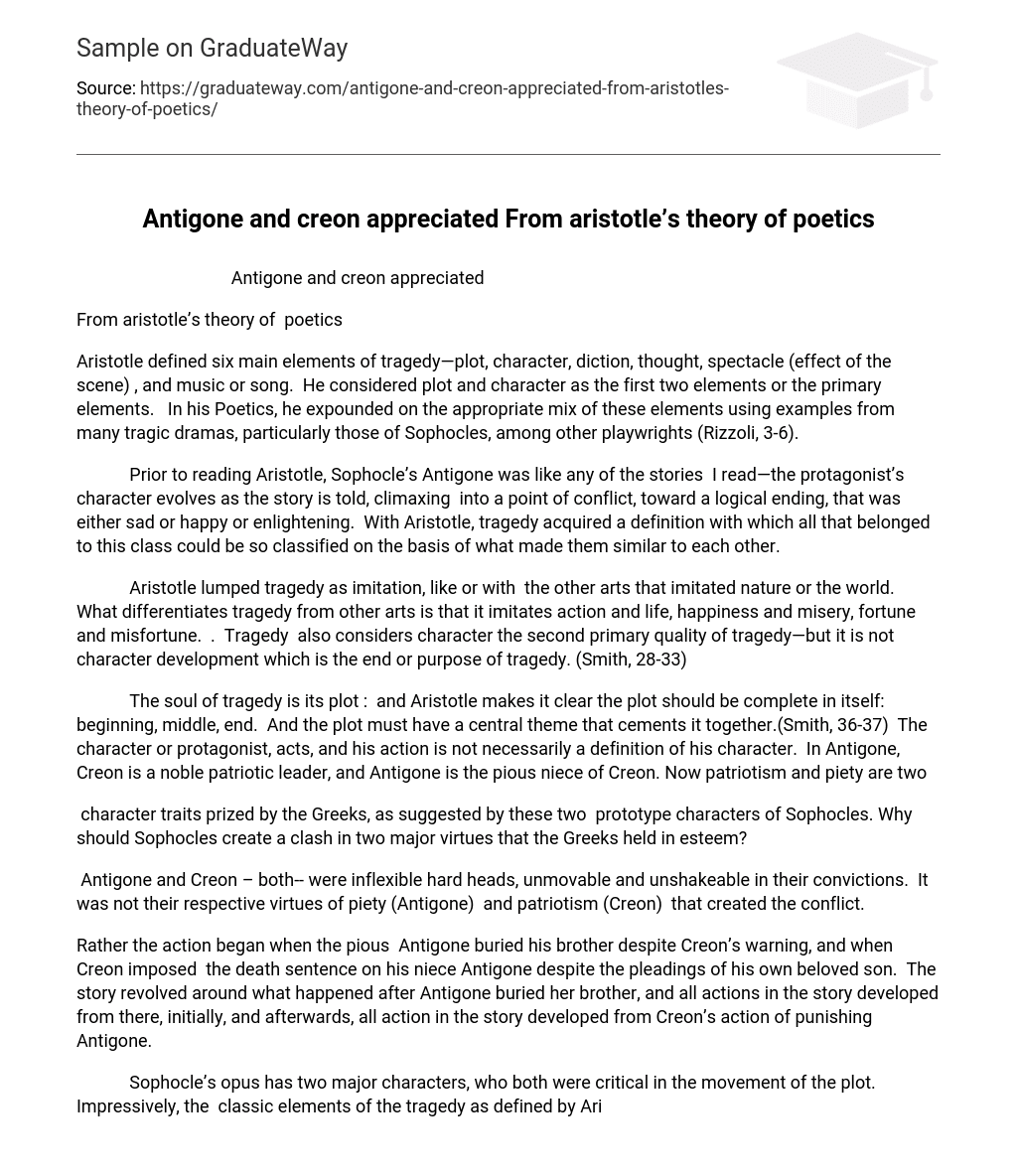Antigone and creon appreciated
From aristotle’s theory of poetics
Aristotle defined six main elements of tragedy—plot, character, diction, thought, spectacle (effect of the scene) , and music or song. He considered plot and character as the first two elements or the primary elements. In his Poetics, he expounded on the appropriate mix of these elements using examples from many tragic dramas, particularly those of Sophocles, among other playwrights (Rizzoli, 3-6).
Prior to reading Aristotle, Sophocle’s Antigone was like any of the stories I read—the protagonist’s character evolves as the story is told, climaxing into a point of conflict, toward a logical ending, that was either sad or happy or enlightening. With Aristotle, tragedy acquired a definition with which all that belonged to this class could be so classified on the basis of what made them similar to each other.
Aristotle lumped tragedy as imitation, like or with the other arts that imitated nature or the world. What differentiates tragedy from other arts is that it imitates action and life, happiness and misery, fortune and misfortune. . Tragedy also considers character the second primary quality of tragedy—but it is not character development which is the end or purpose of tragedy. (Smith, 28-33)
The soul of tragedy is its plot : and Aristotle makes it clear the plot should be complete in itself: beginning, middle, end. And the plot must have a central theme that cements it together.(Smith, 36-37) The character or protagonist, acts, and his action is not necessarily a definition of his character. In Antigone, Creon is a noble patriotic leader, and Antigone is the pious niece of Creon. Now patriotism and piety are two
character traits prized by the Greeks, as suggested by these two prototype characters of Sophocles. Why should Sophocles create a clash in two major virtues that the Greeks held in esteem?
Antigone and Creon – both– were inflexible hard heads, unmovable and unshakeable in their convictions. It was not their respective virtues of piety (Antigone) and patriotism (Creon) that created the conflict.
Rather the action began when the pious Antigone buried his brother despite Creon’s warning, and when Creon imposed the death sentence on his niece Antigone despite the pleadings of his own beloved son. The story revolved around what happened after Antigone buried her brother, and all actions in the story developed from there, initially, and afterwards, all action in the story developed from Creon’s action of punishing Antigone.
Sophocle’s opus has two major characters, who both were critical in the movement of the plot. Impressively, the classic elements of the tragedy as defined by Aristotle were marked in these two sub-plots. The first primary action was focused on Antigone who instigated the ire of Creon when she buried her unpatriotic brother. The second started from that point when Creon ( as King-Law Enforcer), moved to have her killed, in reaction to the instigation started by Antigone herself.
The two sub-plots, the two major characters, thereby would develop into two parallel stories that essentially comprised one tightly integrated cause and effect story (Sternberg, 524), within a time frame consistent with Aristotle’s standard of keeping within the attention span of the spectator or audience. Meanwhile, their characters unfold
without necessarily delving deep into their psychological motivations. Unlike today’s modern writers, Sophocles did not delve deep into the psychological recesses of his protagonists: it was enough to lump them as pious or patriotic, their character traits were givens. Their character did not necessarily define their actions. (I believe these are good contrasting examples: Ismene was not necessarily less pious, but she did not see the need to clash against the power of Creon. Similarly, Creon’s son Haemon was not necessarily less patriotic, but he did not see why his father had to execute Antigone.)
Both Antigone and Creon were tragic characters who meet Aristotle’s definition of the tragic: They were renowned, prosperous; imperfect human ( basically virtuous and just but with enough share of imperfections, with misfortunes caused by errors in judgment. For Aristotle, they have to be renowned so people can identify with them and thereby elicit pity or fear (pity for undeserved fate, and fear for a likelihood of the same misfortune for ourselves.)
Aristotle provides us with a formula that at the very least provided a common language with which to appreciate tragedy. The theory applied twice over to Sophocle’s Antigone, where the theory applied in an impressive case of double and parallel manifestation of validity. The theory enhanced appreciation, because it allowed us to see the validity in two parallel characters moving in a parallel and cause and effect sub-plots, leading to their parallel dual tragic endings.
REFERENCES
Aristotle, W. Rhys Robers, and Ingram Bywater. The Rhetoric and Poetics of Aristotle.
New York: The Modern Library, l984..
Cahn, Steven M. Classics of Western Philosophy by. Retrieved March 28, 2008 from:
books.google.com/books?isbn=0872206378…
Kirkwood, E. A Study of Sophoclean Drama. Ithaca, NY, 1938.
Letters, F.J. H. The Life and Works of Sophocles. Londo, 1953.
Rizzoli, Renato. Representation ad Ideology in Jacobean Drama: The Politics of
the Coup de Theatre. New York: The Edwin Mellen Press, 1999.
Sophocles, Oedipus the King, c. 420 BC. Translated by Ian Johnston of Malaspina
University-College, Nanaimo, BC. Retrieved March 27, 2008 from: records.viu.ca/~johnstoi/sophocles/oedipustheking.htm
Smith, Hames Harry and Parks, Edd Winfield. The Great Critics: An Anthology
of Literary Criticism. New York: Norton and Company, 1951.
Sternberg, Meir. Universals of Narrative and their Cognitive Fortunes. (II)
Poetics Today 24 (2003).





